Pharmacology of Stroke: A Case Study
VerifiedAdded on 2023/06/11
|11
|3209
|439
AI Summary
The paper discusses the pharmacologic management of stroke with reference to the case study of Greta Balodis. It covers the stroke-specific therapy and therapy to prevent recurrence. The linkage between disease process, clinical manifestation, and the pharmacology is provided. Furthermore, the signs or symptoms that show improvement with pharmacotherapy are discussed with clear rationales as to the reason for improvement.
Contribute Materials
Your contribution can guide someone’s learning journey. Share your
documents today.

PHARMACOLGY OF STROKE 1
PHARMACOLOGY OF STROKE: A CASE STUDY
By (Student’s name)
Course
Institutional affiliation
Date
PHARMACOLOGY OF STROKE: A CASE STUDY
By (Student’s name)
Course
Institutional affiliation
Date
Secure Best Marks with AI Grader
Need help grading? Try our AI Grader for instant feedback on your assignments.
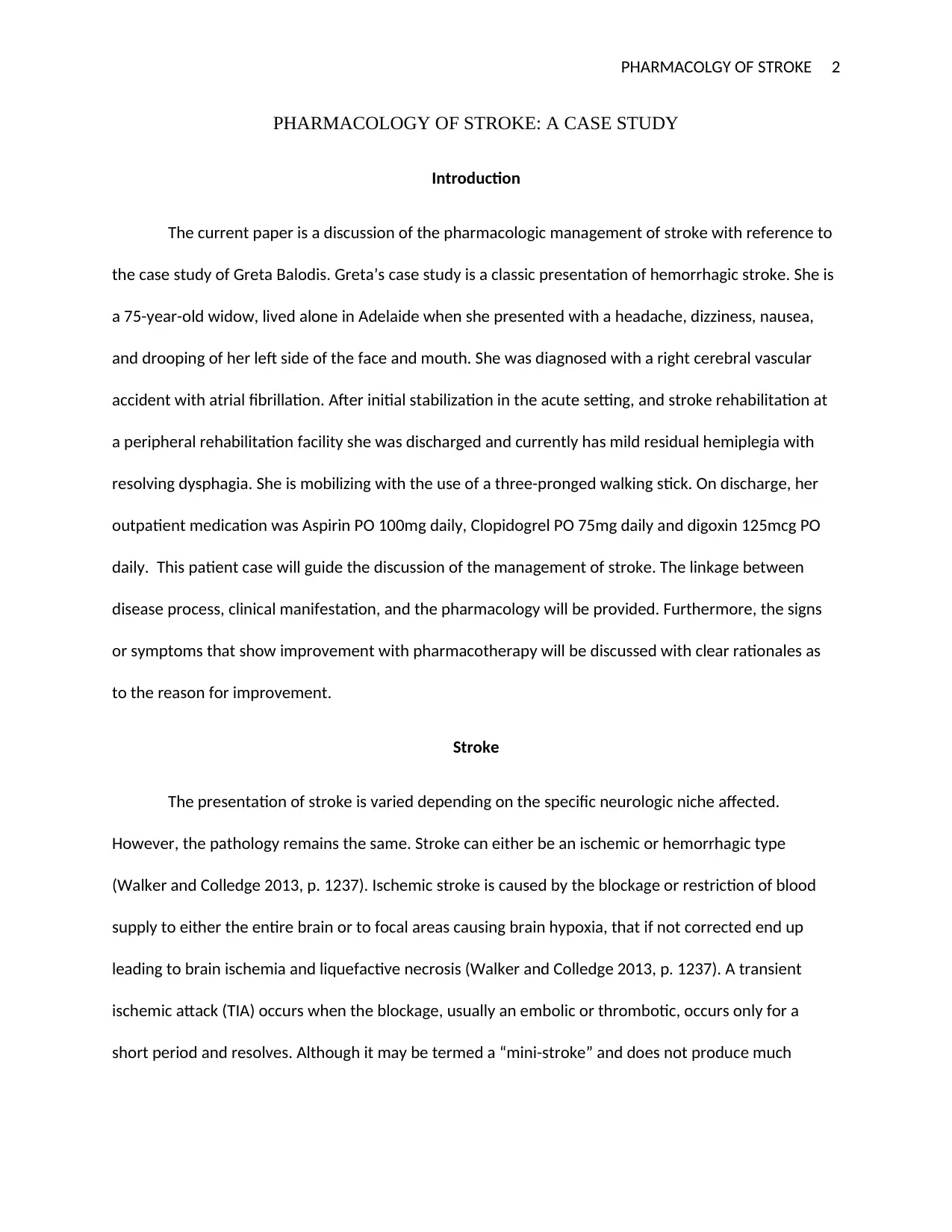
PHARMACOLGY OF STROKE 2
PHARMACOLOGY OF STROKE: A CASE STUDY
Introduction
The current paper is a discussion of the pharmacologic management of stroke with reference to
the case study of Greta Balodis. Greta’s case study is a classic presentation of hemorrhagic stroke. She is
a 75-year-old widow, lived alone in Adelaide when she presented with a headache, dizziness, nausea,
and drooping of her left side of the face and mouth. She was diagnosed with a right cerebral vascular
accident with atrial fibrillation. After initial stabilization in the acute setting, and stroke rehabilitation at
a peripheral rehabilitation facility she was discharged and currently has mild residual hemiplegia with
resolving dysphagia. She is mobilizing with the use of a three-pronged walking stick. On discharge, her
outpatient medication was Aspirin PO 100mg daily, Clopidogrel PO 75mg daily and digoxin 125mcg PO
daily. This patient case will guide the discussion of the management of stroke. The linkage between
disease process, clinical manifestation, and the pharmacology will be provided. Furthermore, the signs
or symptoms that show improvement with pharmacotherapy will be discussed with clear rationales as
to the reason for improvement.
Stroke
The presentation of stroke is varied depending on the specific neurologic niche affected.
However, the pathology remains the same. Stroke can either be an ischemic or hemorrhagic type
(Walker and Colledge 2013, p. 1237). Ischemic stroke is caused by the blockage or restriction of blood
supply to either the entire brain or to focal areas causing brain hypoxia, that if not corrected end up
leading to brain ischemia and liquefactive necrosis (Walker and Colledge 2013, p. 1237). A transient
ischemic attack (TIA) occurs when the blockage, usually an embolic or thrombotic, occurs only for a
short period and resolves. Although it may be termed a “mini-stroke” and does not produce much
PHARMACOLOGY OF STROKE: A CASE STUDY
Introduction
The current paper is a discussion of the pharmacologic management of stroke with reference to
the case study of Greta Balodis. Greta’s case study is a classic presentation of hemorrhagic stroke. She is
a 75-year-old widow, lived alone in Adelaide when she presented with a headache, dizziness, nausea,
and drooping of her left side of the face and mouth. She was diagnosed with a right cerebral vascular
accident with atrial fibrillation. After initial stabilization in the acute setting, and stroke rehabilitation at
a peripheral rehabilitation facility she was discharged and currently has mild residual hemiplegia with
resolving dysphagia. She is mobilizing with the use of a three-pronged walking stick. On discharge, her
outpatient medication was Aspirin PO 100mg daily, Clopidogrel PO 75mg daily and digoxin 125mcg PO
daily. This patient case will guide the discussion of the management of stroke. The linkage between
disease process, clinical manifestation, and the pharmacology will be provided. Furthermore, the signs
or symptoms that show improvement with pharmacotherapy will be discussed with clear rationales as
to the reason for improvement.
Stroke
The presentation of stroke is varied depending on the specific neurologic niche affected.
However, the pathology remains the same. Stroke can either be an ischemic or hemorrhagic type
(Walker and Colledge 2013, p. 1237). Ischemic stroke is caused by the blockage or restriction of blood
supply to either the entire brain or to focal areas causing brain hypoxia, that if not corrected end up
leading to brain ischemia and liquefactive necrosis (Walker and Colledge 2013, p. 1237). A transient
ischemic attack (TIA) occurs when the blockage, usually an embolic or thrombotic, occurs only for a
short period and resolves. Although it may be termed a “mini-stroke” and does not produce much
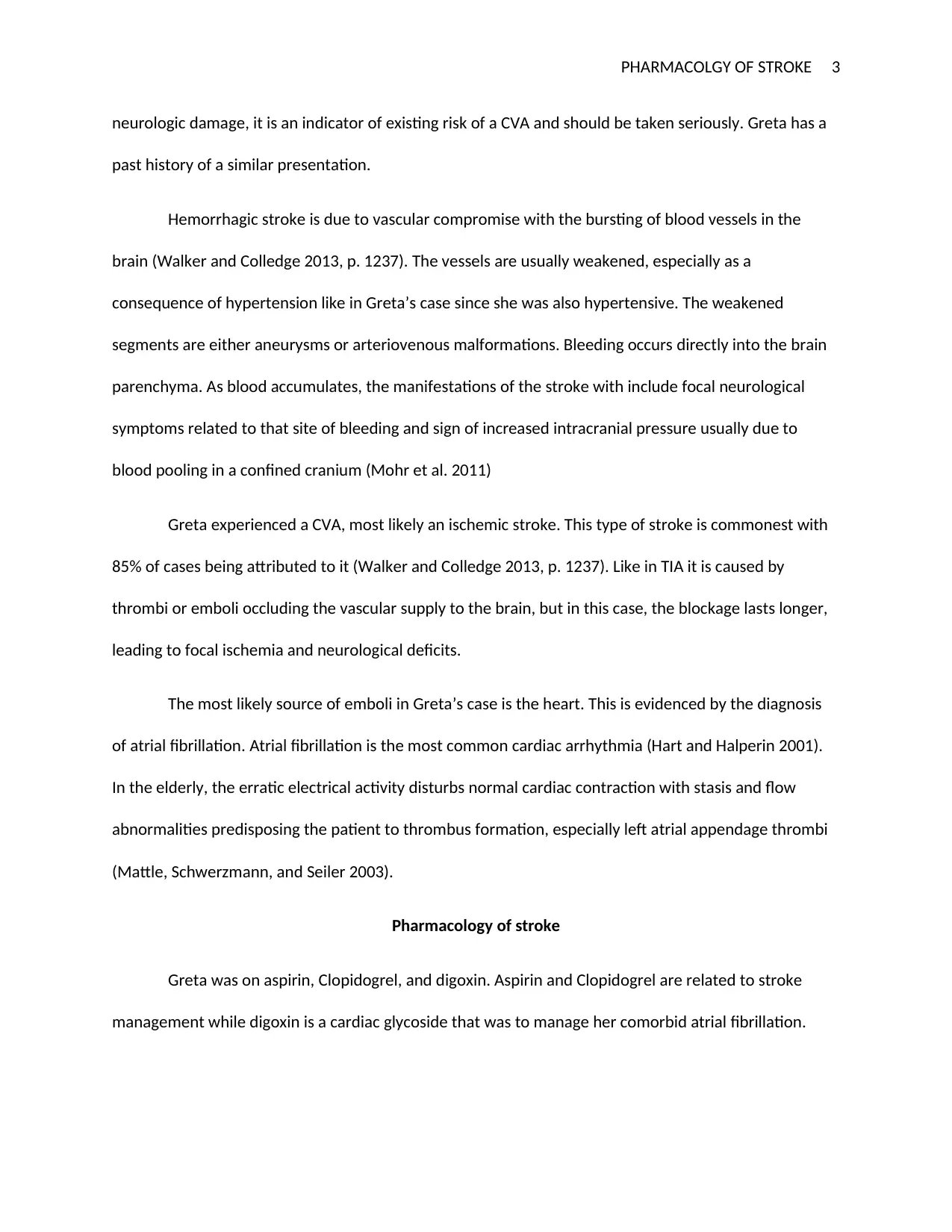
PHARMACOLGY OF STROKE 3
neurologic damage, it is an indicator of existing risk of a CVA and should be taken seriously. Greta has a
past history of a similar presentation.
Hemorrhagic stroke is due to vascular compromise with the bursting of blood vessels in the
brain (Walker and Colledge 2013, p. 1237). The vessels are usually weakened, especially as a
consequence of hypertension like in Greta’s case since she was also hypertensive. The weakened
segments are either aneurysms or arteriovenous malformations. Bleeding occurs directly into the brain
parenchyma. As blood accumulates, the manifestations of the stroke with include focal neurological
symptoms related to that site of bleeding and sign of increased intracranial pressure usually due to
blood pooling in a confined cranium (Mohr et al. 2011)
Greta experienced a CVA, most likely an ischemic stroke. This type of stroke is commonest with
85% of cases being attributed to it (Walker and Colledge 2013, p. 1237). Like in TIA it is caused by
thrombi or emboli occluding the vascular supply to the brain, but in this case, the blockage lasts longer,
leading to focal ischemia and neurological deficits.
The most likely source of emboli in Greta’s case is the heart. This is evidenced by the diagnosis
of atrial fibrillation. Atrial fibrillation is the most common cardiac arrhythmia (Hart and Halperin 2001).
In the elderly, the erratic electrical activity disturbs normal cardiac contraction with stasis and flow
abnormalities predisposing the patient to thrombus formation, especially left atrial appendage thrombi
(Mattle, Schwerzmann, and Seiler 2003).
Pharmacology of stroke
Greta was on aspirin, Clopidogrel, and digoxin. Aspirin and Clopidogrel are related to stroke
management while digoxin is a cardiac glycoside that was to manage her comorbid atrial fibrillation.
neurologic damage, it is an indicator of existing risk of a CVA and should be taken seriously. Greta has a
past history of a similar presentation.
Hemorrhagic stroke is due to vascular compromise with the bursting of blood vessels in the
brain (Walker and Colledge 2013, p. 1237). The vessels are usually weakened, especially as a
consequence of hypertension like in Greta’s case since she was also hypertensive. The weakened
segments are either aneurysms or arteriovenous malformations. Bleeding occurs directly into the brain
parenchyma. As blood accumulates, the manifestations of the stroke with include focal neurological
symptoms related to that site of bleeding and sign of increased intracranial pressure usually due to
blood pooling in a confined cranium (Mohr et al. 2011)
Greta experienced a CVA, most likely an ischemic stroke. This type of stroke is commonest with
85% of cases being attributed to it (Walker and Colledge 2013, p. 1237). Like in TIA it is caused by
thrombi or emboli occluding the vascular supply to the brain, but in this case, the blockage lasts longer,
leading to focal ischemia and neurological deficits.
The most likely source of emboli in Greta’s case is the heart. This is evidenced by the diagnosis
of atrial fibrillation. Atrial fibrillation is the most common cardiac arrhythmia (Hart and Halperin 2001).
In the elderly, the erratic electrical activity disturbs normal cardiac contraction with stasis and flow
abnormalities predisposing the patient to thrombus formation, especially left atrial appendage thrombi
(Mattle, Schwerzmann, and Seiler 2003).
Pharmacology of stroke
Greta was on aspirin, Clopidogrel, and digoxin. Aspirin and Clopidogrel are related to stroke
management while digoxin is a cardiac glycoside that was to manage her comorbid atrial fibrillation.
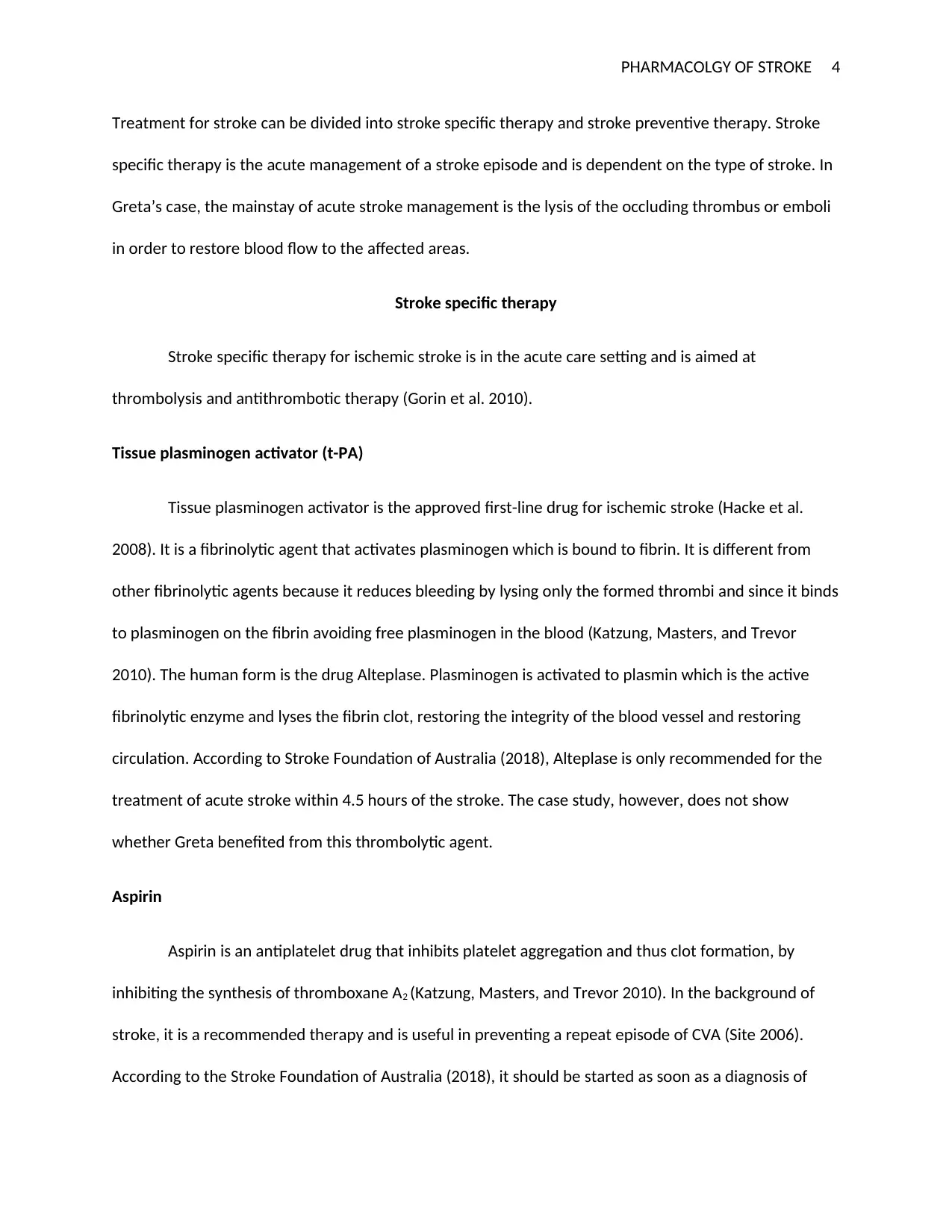
PHARMACOLGY OF STROKE 4
Treatment for stroke can be divided into stroke specific therapy and stroke preventive therapy. Stroke
specific therapy is the acute management of a stroke episode and is dependent on the type of stroke. In
Greta’s case, the mainstay of acute stroke management is the lysis of the occluding thrombus or emboli
in order to restore blood flow to the affected areas.
Stroke specific therapy
Stroke specific therapy for ischemic stroke is in the acute care setting and is aimed at
thrombolysis and antithrombotic therapy (Gorin et al. 2010).
Tissue plasminogen activator (t-PA)
Tissue plasminogen activator is the approved first-line drug for ischemic stroke (Hacke et al.
2008). It is a fibrinolytic agent that activates plasminogen which is bound to fibrin. It is different from
other fibrinolytic agents because it reduces bleeding by lysing only the formed thrombi and since it binds
to plasminogen on the fibrin avoiding free plasminogen in the blood (Katzung, Masters, and Trevor
2010). The human form is the drug Alteplase. Plasminogen is activated to plasmin which is the active
fibrinolytic enzyme and lyses the fibrin clot, restoring the integrity of the blood vessel and restoring
circulation. According to Stroke Foundation of Australia (2018), Alteplase is only recommended for the
treatment of acute stroke within 4.5 hours of the stroke. The case study, however, does not show
whether Greta benefited from this thrombolytic agent.
Aspirin
Aspirin is an antiplatelet drug that inhibits platelet aggregation and thus clot formation, by
inhibiting the synthesis of thromboxane A2 (Katzung, Masters, and Trevor 2010). In the background of
stroke, it is a recommended therapy and is useful in preventing a repeat episode of CVA (Site 2006).
According to the Stroke Foundation of Australia (2018), it should be started as soon as a diagnosis of
Treatment for stroke can be divided into stroke specific therapy and stroke preventive therapy. Stroke
specific therapy is the acute management of a stroke episode and is dependent on the type of stroke. In
Greta’s case, the mainstay of acute stroke management is the lysis of the occluding thrombus or emboli
in order to restore blood flow to the affected areas.
Stroke specific therapy
Stroke specific therapy for ischemic stroke is in the acute care setting and is aimed at
thrombolysis and antithrombotic therapy (Gorin et al. 2010).
Tissue plasminogen activator (t-PA)
Tissue plasminogen activator is the approved first-line drug for ischemic stroke (Hacke et al.
2008). It is a fibrinolytic agent that activates plasminogen which is bound to fibrin. It is different from
other fibrinolytic agents because it reduces bleeding by lysing only the formed thrombi and since it binds
to plasminogen on the fibrin avoiding free plasminogen in the blood (Katzung, Masters, and Trevor
2010). The human form is the drug Alteplase. Plasminogen is activated to plasmin which is the active
fibrinolytic enzyme and lyses the fibrin clot, restoring the integrity of the blood vessel and restoring
circulation. According to Stroke Foundation of Australia (2018), Alteplase is only recommended for the
treatment of acute stroke within 4.5 hours of the stroke. The case study, however, does not show
whether Greta benefited from this thrombolytic agent.
Aspirin
Aspirin is an antiplatelet drug that inhibits platelet aggregation and thus clot formation, by
inhibiting the synthesis of thromboxane A2 (Katzung, Masters, and Trevor 2010). In the background of
stroke, it is a recommended therapy and is useful in preventing a repeat episode of CVA (Site 2006).
According to the Stroke Foundation of Australia (2018), it should be started as soon as a diagnosis of
Secure Best Marks with AI Grader
Need help grading? Try our AI Grader for instant feedback on your assignments.
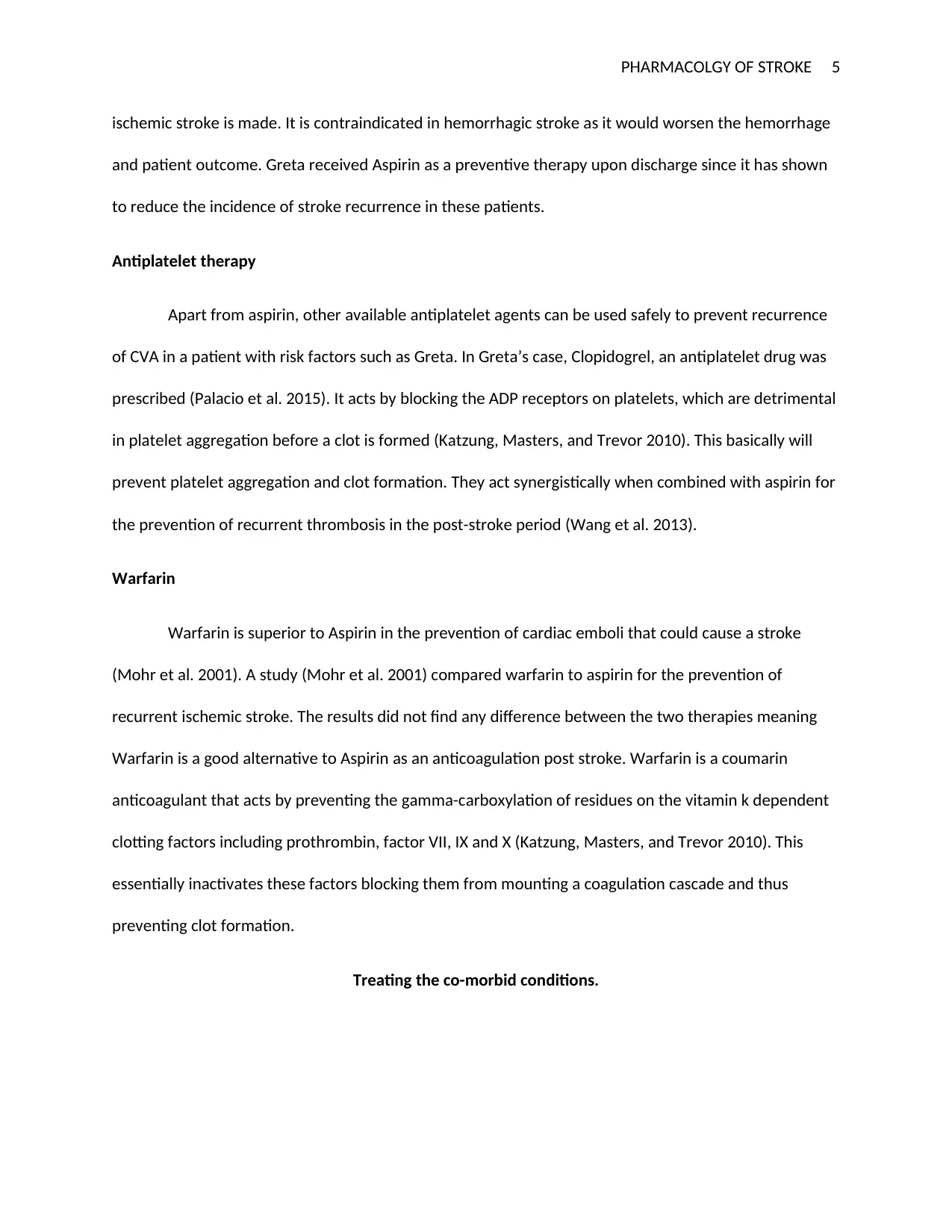
PHARMACOLGY OF STROKE 5
ischemic stroke is made. It is contraindicated in hemorrhagic stroke as it would worsen the hemorrhage
and patient outcome. Greta received Aspirin as a preventive therapy upon discharge since it has shown
to reduce the incidence of stroke recurrence in these patients.
Antiplatelet therapy
Apart from aspirin, other available antiplatelet agents can be used safely to prevent recurrence
of CVA in a patient with risk factors such as Greta. In Greta’s case, Clopidogrel, an antiplatelet drug was
prescribed (Palacio et al. 2015). It acts by blocking the ADP receptors on platelets, which are detrimental
in platelet aggregation before a clot is formed (Katzung, Masters, and Trevor 2010). This basically will
prevent platelet aggregation and clot formation. They act synergistically when combined with aspirin for
the prevention of recurrent thrombosis in the post-stroke period (Wang et al. 2013).
Warfarin
Warfarin is superior to Aspirin in the prevention of cardiac emboli that could cause a stroke
(Mohr et al. 2001). A study (Mohr et al. 2001) compared warfarin to aspirin for the prevention of
recurrent ischemic stroke. The results did not find any difference between the two therapies meaning
Warfarin is a good alternative to Aspirin as an anticoagulation post stroke. Warfarin is a coumarin
anticoagulant that acts by preventing the gamma-carboxylation of residues on the vitamin k dependent
clotting factors including prothrombin, factor VII, IX and X (Katzung, Masters, and Trevor 2010). This
essentially inactivates these factors blocking them from mounting a coagulation cascade and thus
preventing clot formation.
Treating the co-morbid conditions.
ischemic stroke is made. It is contraindicated in hemorrhagic stroke as it would worsen the hemorrhage
and patient outcome. Greta received Aspirin as a preventive therapy upon discharge since it has shown
to reduce the incidence of stroke recurrence in these patients.
Antiplatelet therapy
Apart from aspirin, other available antiplatelet agents can be used safely to prevent recurrence
of CVA in a patient with risk factors such as Greta. In Greta’s case, Clopidogrel, an antiplatelet drug was
prescribed (Palacio et al. 2015). It acts by blocking the ADP receptors on platelets, which are detrimental
in platelet aggregation before a clot is formed (Katzung, Masters, and Trevor 2010). This basically will
prevent platelet aggregation and clot formation. They act synergistically when combined with aspirin for
the prevention of recurrent thrombosis in the post-stroke period (Wang et al. 2013).
Warfarin
Warfarin is superior to Aspirin in the prevention of cardiac emboli that could cause a stroke
(Mohr et al. 2001). A study (Mohr et al. 2001) compared warfarin to aspirin for the prevention of
recurrent ischemic stroke. The results did not find any difference between the two therapies meaning
Warfarin is a good alternative to Aspirin as an anticoagulation post stroke. Warfarin is a coumarin
anticoagulant that acts by preventing the gamma-carboxylation of residues on the vitamin k dependent
clotting factors including prothrombin, factor VII, IX and X (Katzung, Masters, and Trevor 2010). This
essentially inactivates these factors blocking them from mounting a coagulation cascade and thus
preventing clot formation.
Treating the co-morbid conditions.
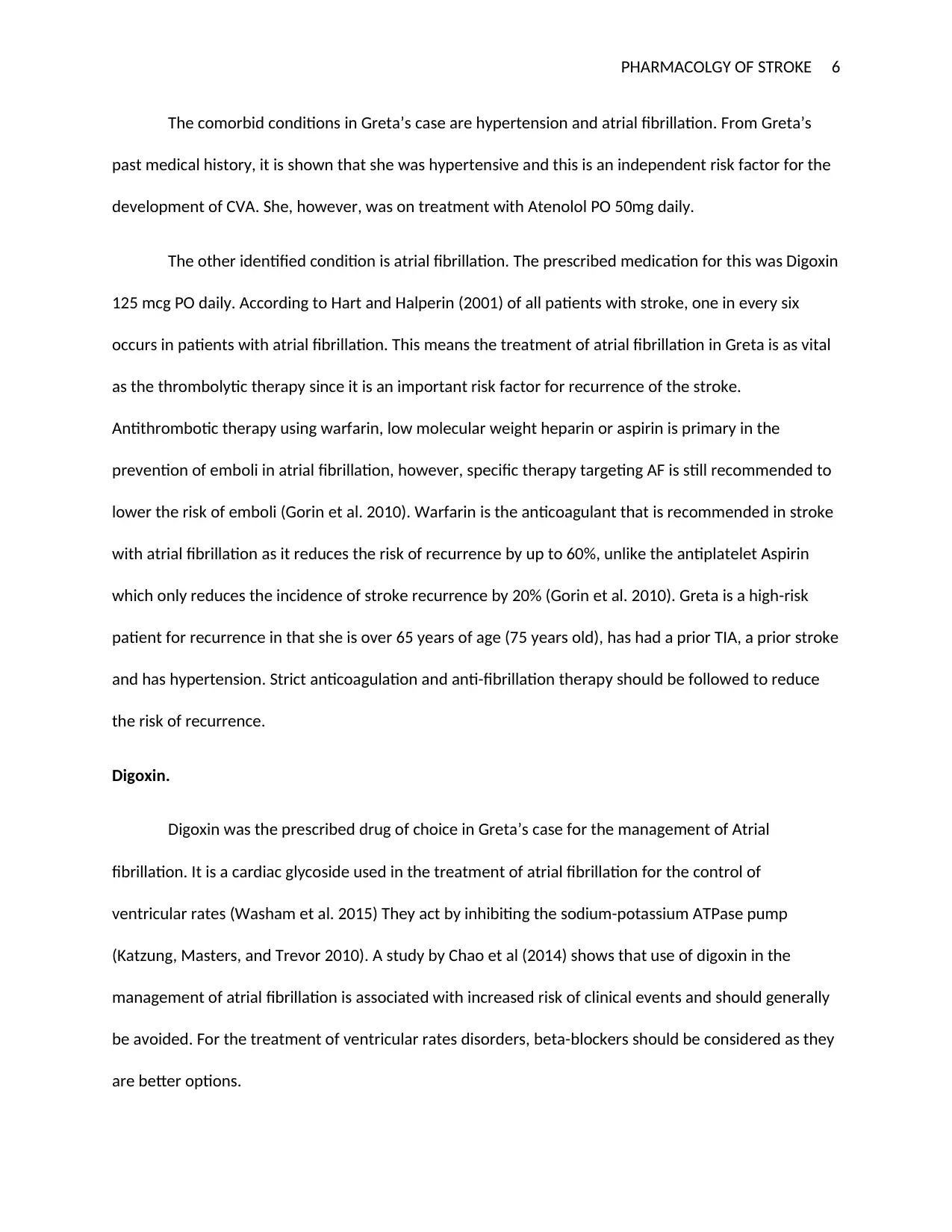
PHARMACOLGY OF STROKE 6
The comorbid conditions in Greta’s case are hypertension and atrial fibrillation. From Greta’s
past medical history, it is shown that she was hypertensive and this is an independent risk factor for the
development of CVA. She, however, was on treatment with Atenolol PO 50mg daily.
The other identified condition is atrial fibrillation. The prescribed medication for this was Digoxin
125 mcg PO daily. According to Hart and Halperin (2001) of all patients with stroke, one in every six
occurs in patients with atrial fibrillation. This means the treatment of atrial fibrillation in Greta is as vital
as the thrombolytic therapy since it is an important risk factor for recurrence of the stroke.
Antithrombotic therapy using warfarin, low molecular weight heparin or aspirin is primary in the
prevention of emboli in atrial fibrillation, however, specific therapy targeting AF is still recommended to
lower the risk of emboli (Gorin et al. 2010). Warfarin is the anticoagulant that is recommended in stroke
with atrial fibrillation as it reduces the risk of recurrence by up to 60%, unlike the antiplatelet Aspirin
which only reduces the incidence of stroke recurrence by 20% (Gorin et al. 2010). Greta is a high-risk
patient for recurrence in that she is over 65 years of age (75 years old), has had a prior TIA, a prior stroke
and has hypertension. Strict anticoagulation and anti-fibrillation therapy should be followed to reduce
the risk of recurrence.
Digoxin.
Digoxin was the prescribed drug of choice in Greta’s case for the management of Atrial
fibrillation. It is a cardiac glycoside used in the treatment of atrial fibrillation for the control of
ventricular rates (Washam et al. 2015) They act by inhibiting the sodium-potassium ATPase pump
(Katzung, Masters, and Trevor 2010). A study by Chao et al (2014) shows that use of digoxin in the
management of atrial fibrillation is associated with increased risk of clinical events and should generally
be avoided. For the treatment of ventricular rates disorders, beta-blockers should be considered as they
are better options.
The comorbid conditions in Greta’s case are hypertension and atrial fibrillation. From Greta’s
past medical history, it is shown that she was hypertensive and this is an independent risk factor for the
development of CVA. She, however, was on treatment with Atenolol PO 50mg daily.
The other identified condition is atrial fibrillation. The prescribed medication for this was Digoxin
125 mcg PO daily. According to Hart and Halperin (2001) of all patients with stroke, one in every six
occurs in patients with atrial fibrillation. This means the treatment of atrial fibrillation in Greta is as vital
as the thrombolytic therapy since it is an important risk factor for recurrence of the stroke.
Antithrombotic therapy using warfarin, low molecular weight heparin or aspirin is primary in the
prevention of emboli in atrial fibrillation, however, specific therapy targeting AF is still recommended to
lower the risk of emboli (Gorin et al. 2010). Warfarin is the anticoagulant that is recommended in stroke
with atrial fibrillation as it reduces the risk of recurrence by up to 60%, unlike the antiplatelet Aspirin
which only reduces the incidence of stroke recurrence by 20% (Gorin et al. 2010). Greta is a high-risk
patient for recurrence in that she is over 65 years of age (75 years old), has had a prior TIA, a prior stroke
and has hypertension. Strict anticoagulation and anti-fibrillation therapy should be followed to reduce
the risk of recurrence.
Digoxin.
Digoxin was the prescribed drug of choice in Greta’s case for the management of Atrial
fibrillation. It is a cardiac glycoside used in the treatment of atrial fibrillation for the control of
ventricular rates (Washam et al. 2015) They act by inhibiting the sodium-potassium ATPase pump
(Katzung, Masters, and Trevor 2010). A study by Chao et al (2014) shows that use of digoxin in the
management of atrial fibrillation is associated with increased risk of clinical events and should generally
be avoided. For the treatment of ventricular rates disorders, beta-blockers should be considered as they
are better options.
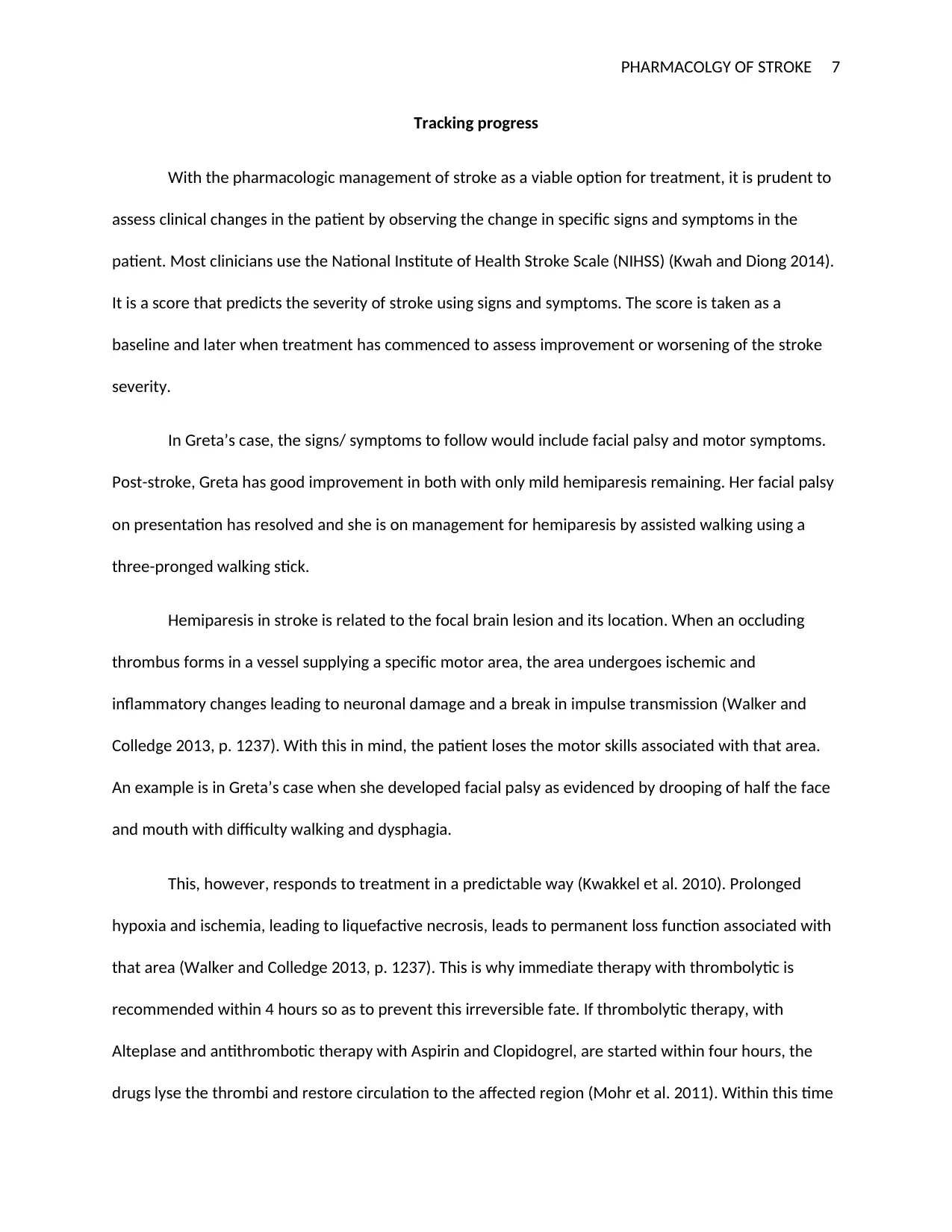
PHARMACOLGY OF STROKE 7
Tracking progress
With the pharmacologic management of stroke as a viable option for treatment, it is prudent to
assess clinical changes in the patient by observing the change in specific signs and symptoms in the
patient. Most clinicians use the National Institute of Health Stroke Scale (NIHSS) (Kwah and Diong 2014).
It is a score that predicts the severity of stroke using signs and symptoms. The score is taken as a
baseline and later when treatment has commenced to assess improvement or worsening of the stroke
severity.
In Greta’s case, the signs/ symptoms to follow would include facial palsy and motor symptoms.
Post-stroke, Greta has good improvement in both with only mild hemiparesis remaining. Her facial palsy
on presentation has resolved and she is on management for hemiparesis by assisted walking using a
three-pronged walking stick.
Hemiparesis in stroke is related to the focal brain lesion and its location. When an occluding
thrombus forms in a vessel supplying a specific motor area, the area undergoes ischemic and
inflammatory changes leading to neuronal damage and a break in impulse transmission (Walker and
Colledge 2013, p. 1237). With this in mind, the patient loses the motor skills associated with that area.
An example is in Greta’s case when she developed facial palsy as evidenced by drooping of half the face
and mouth with difficulty walking and dysphagia.
This, however, responds to treatment in a predictable way (Kwakkel et al. 2010). Prolonged
hypoxia and ischemia, leading to liquefactive necrosis, leads to permanent loss function associated with
that area (Walker and Colledge 2013, p. 1237). This is why immediate therapy with thrombolytic is
recommended within 4 hours so as to prevent this irreversible fate. If thrombolytic therapy, with
Alteplase and antithrombotic therapy with Aspirin and Clopidogrel, are started within four hours, the
drugs lyse the thrombi and restore circulation to the affected region (Mohr et al. 2011). Within this time
Tracking progress
With the pharmacologic management of stroke as a viable option for treatment, it is prudent to
assess clinical changes in the patient by observing the change in specific signs and symptoms in the
patient. Most clinicians use the National Institute of Health Stroke Scale (NIHSS) (Kwah and Diong 2014).
It is a score that predicts the severity of stroke using signs and symptoms. The score is taken as a
baseline and later when treatment has commenced to assess improvement or worsening of the stroke
severity.
In Greta’s case, the signs/ symptoms to follow would include facial palsy and motor symptoms.
Post-stroke, Greta has good improvement in both with only mild hemiparesis remaining. Her facial palsy
on presentation has resolved and she is on management for hemiparesis by assisted walking using a
three-pronged walking stick.
Hemiparesis in stroke is related to the focal brain lesion and its location. When an occluding
thrombus forms in a vessel supplying a specific motor area, the area undergoes ischemic and
inflammatory changes leading to neuronal damage and a break in impulse transmission (Walker and
Colledge 2013, p. 1237). With this in mind, the patient loses the motor skills associated with that area.
An example is in Greta’s case when she developed facial palsy as evidenced by drooping of half the face
and mouth with difficulty walking and dysphagia.
This, however, responds to treatment in a predictable way (Kwakkel et al. 2010). Prolonged
hypoxia and ischemia, leading to liquefactive necrosis, leads to permanent loss function associated with
that area (Walker and Colledge 2013, p. 1237). This is why immediate therapy with thrombolytic is
recommended within 4 hours so as to prevent this irreversible fate. If thrombolytic therapy, with
Alteplase and antithrombotic therapy with Aspirin and Clopidogrel, are started within four hours, the
drugs lyse the thrombi and restore circulation to the affected region (Mohr et al. 2011). Within this time
Paraphrase This Document
Need a fresh take? Get an instant paraphrase of this document with our AI Paraphraser

PHARMACOLGY OF STROKE 8
frame, the homeostatic mechanisms may have been depleted but the neurons are still viable.
Improvement with pharmacologic therapy thus occurs.
Conclusion
The case study was of Greta Balodis, a patient with a diagnosis of cerebrovascular accident and
atrial fibrillation. The stroke specific therapy she was prescribed included Aspirin, Clopidogrel, and
Digoxin. She appears to have suffered an ischemic stroke following the predisposition of hypertension
and atrial fibrillation. The pharmacologic management of ischemic stroke can be divided into the stroke-
specific therapy and therapy to prevent recurrence. Alteplase, a tissue plasminogen activator is the only
drug approved for the treatment of acute stroke and is given within 4.5 hours. Antiplatelets including
Aspirin and Clopidogrel are used for the prevention of further clot formation and as modalities for the
treatment of cardiac emboli due to atrial fibrillation. They are however not as useful as warfarin in the
prevention of recurrent stroke in atrial fibrillation.
In the monitoring of improvement, symptoms identified by the NIHSS should be used as they are
good predictors of patient outcome. Greta has improvement in facial palsy and motor movements as
evidenced by her being able to mobilize with the aid of a walking stick. This improvement can be linked
to pharmacotherapy that is timely enough to restore brain perfusion before irreversible neuronal death
ensues.
frame, the homeostatic mechanisms may have been depleted but the neurons are still viable.
Improvement with pharmacologic therapy thus occurs.
Conclusion
The case study was of Greta Balodis, a patient with a diagnosis of cerebrovascular accident and
atrial fibrillation. The stroke specific therapy she was prescribed included Aspirin, Clopidogrel, and
Digoxin. She appears to have suffered an ischemic stroke following the predisposition of hypertension
and atrial fibrillation. The pharmacologic management of ischemic stroke can be divided into the stroke-
specific therapy and therapy to prevent recurrence. Alteplase, a tissue plasminogen activator is the only
drug approved for the treatment of acute stroke and is given within 4.5 hours. Antiplatelets including
Aspirin and Clopidogrel are used for the prevention of further clot formation and as modalities for the
treatment of cardiac emboli due to atrial fibrillation. They are however not as useful as warfarin in the
prevention of recurrent stroke in atrial fibrillation.
In the monitoring of improvement, symptoms identified by the NIHSS should be used as they are
good predictors of patient outcome. Greta has improvement in facial palsy and motor movements as
evidenced by her being able to mobilize with the aid of a walking stick. This improvement can be linked
to pharmacotherapy that is timely enough to restore brain perfusion before irreversible neuronal death
ensues.
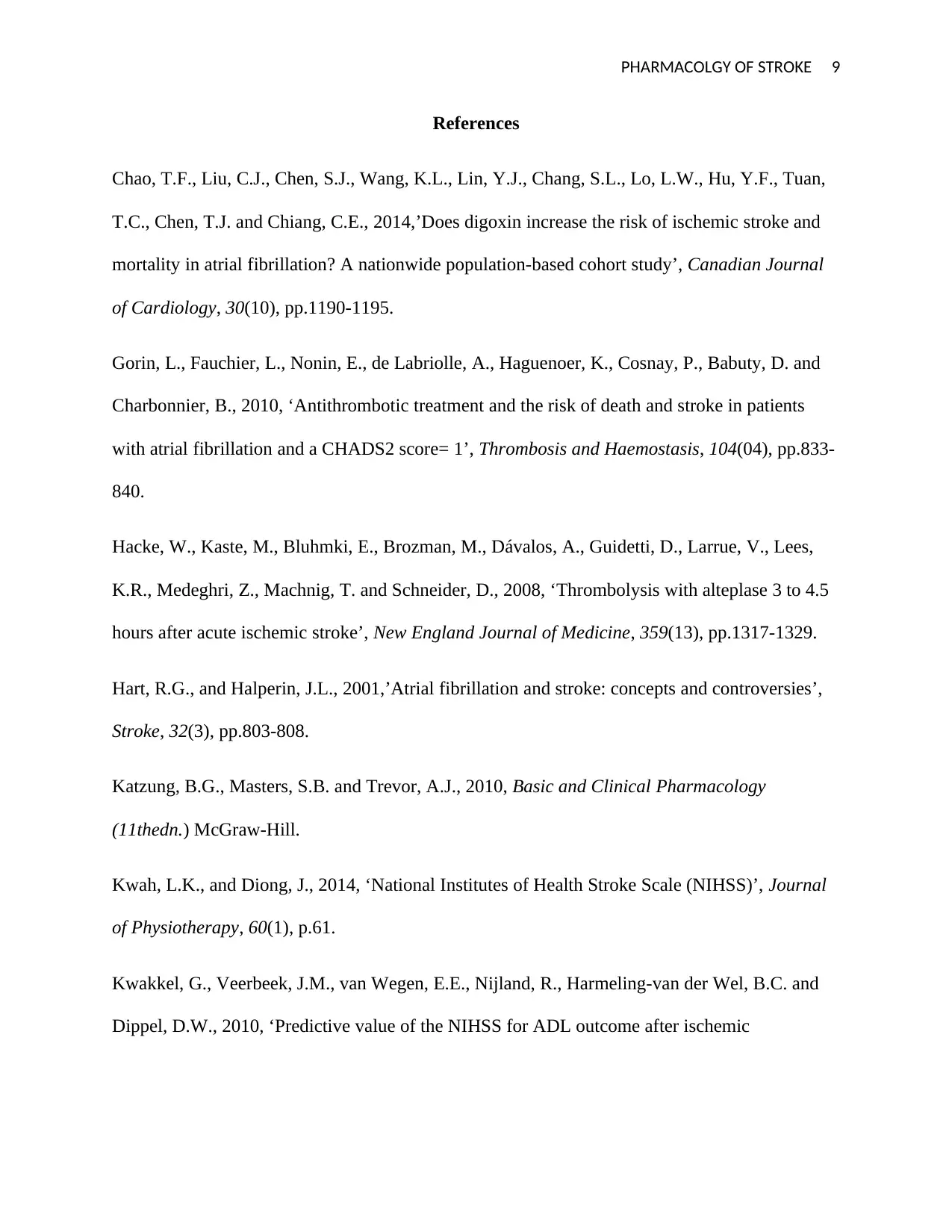
PHARMACOLGY OF STROKE 9
References
Chao, T.F., Liu, C.J., Chen, S.J., Wang, K.L., Lin, Y.J., Chang, S.L., Lo, L.W., Hu, Y.F., Tuan,
T.C., Chen, T.J. and Chiang, C.E., 2014,’Does digoxin increase the risk of ischemic stroke and
mortality in atrial fibrillation? A nationwide population-based cohort study’, Canadian Journal
of Cardiology, 30(10), pp.1190-1195.
Gorin, L., Fauchier, L., Nonin, E., de Labriolle, A., Haguenoer, K., Cosnay, P., Babuty, D. and
Charbonnier, B., 2010, ‘Antithrombotic treatment and the risk of death and stroke in patients
with atrial fibrillation and a CHADS2 score= 1’, Thrombosis and Haemostasis, 104(04), pp.833-
840.
Hacke, W., Kaste, M., Bluhmki, E., Brozman, M., Dávalos, A., Guidetti, D., Larrue, V., Lees,
K.R., Medeghri, Z., Machnig, T. and Schneider, D., 2008, ‘Thrombolysis with alteplase 3 to 4.5
hours after acute ischemic stroke’, New England Journal of Medicine, 359(13), pp.1317-1329.
Hart, R.G., and Halperin, J.L., 2001,’Atrial fibrillation and stroke: concepts and controversies’,
Stroke, 32(3), pp.803-808.
Katzung, B.G., Masters, S.B. and Trevor, A.J., 2010, Basic and Clinical Pharmacology
(11thedn.) McGraw-Hill.
Kwah, L.K., and Diong, J., 2014, ‘National Institutes of Health Stroke Scale (NIHSS)’, Journal
of Physiotherapy, 60(1), p.61.
Kwakkel, G., Veerbeek, J.M., van Wegen, E.E., Nijland, R., Harmeling-van der Wel, B.C. and
Dippel, D.W., 2010, ‘Predictive value of the NIHSS for ADL outcome after ischemic
References
Chao, T.F., Liu, C.J., Chen, S.J., Wang, K.L., Lin, Y.J., Chang, S.L., Lo, L.W., Hu, Y.F., Tuan,
T.C., Chen, T.J. and Chiang, C.E., 2014,’Does digoxin increase the risk of ischemic stroke and
mortality in atrial fibrillation? A nationwide population-based cohort study’, Canadian Journal
of Cardiology, 30(10), pp.1190-1195.
Gorin, L., Fauchier, L., Nonin, E., de Labriolle, A., Haguenoer, K., Cosnay, P., Babuty, D. and
Charbonnier, B., 2010, ‘Antithrombotic treatment and the risk of death and stroke in patients
with atrial fibrillation and a CHADS2 score= 1’, Thrombosis and Haemostasis, 104(04), pp.833-
840.
Hacke, W., Kaste, M., Bluhmki, E., Brozman, M., Dávalos, A., Guidetti, D., Larrue, V., Lees,
K.R., Medeghri, Z., Machnig, T. and Schneider, D., 2008, ‘Thrombolysis with alteplase 3 to 4.5
hours after acute ischemic stroke’, New England Journal of Medicine, 359(13), pp.1317-1329.
Hart, R.G., and Halperin, J.L., 2001,’Atrial fibrillation and stroke: concepts and controversies’,
Stroke, 32(3), pp.803-808.
Katzung, B.G., Masters, S.B. and Trevor, A.J., 2010, Basic and Clinical Pharmacology
(11thedn.) McGraw-Hill.
Kwah, L.K., and Diong, J., 2014, ‘National Institutes of Health Stroke Scale (NIHSS)’, Journal
of Physiotherapy, 60(1), p.61.
Kwakkel, G., Veerbeek, J.M., van Wegen, E.E., Nijland, R., Harmeling-van der Wel, B.C. and
Dippel, D.W., 2010, ‘Predictive value of the NIHSS for ADL outcome after ischemic
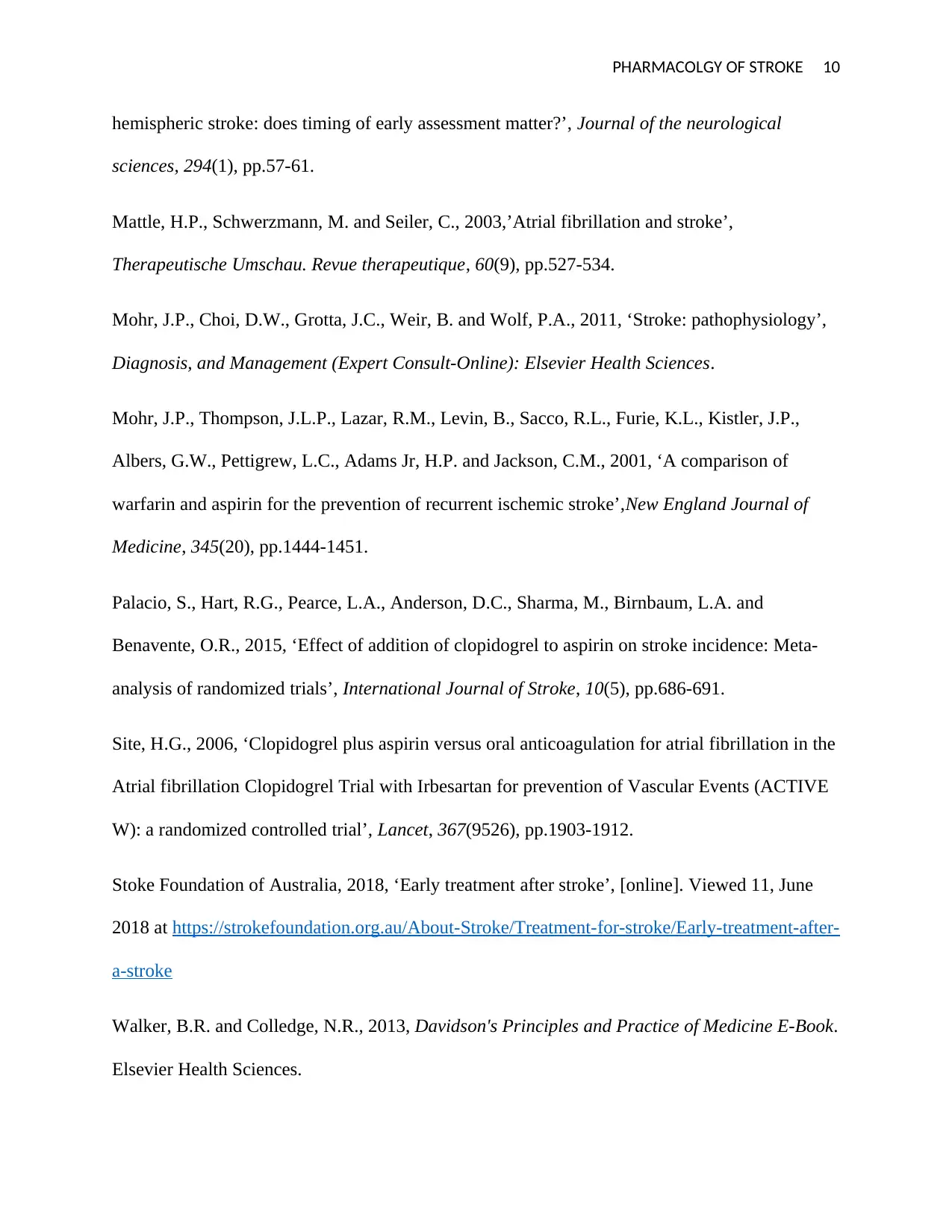
PHARMACOLGY OF STROKE 10
hemispheric stroke: does timing of early assessment matter?’, Journal of the neurological
sciences, 294(1), pp.57-61.
Mattle, H.P., Schwerzmann, M. and Seiler, C., 2003,’Atrial fibrillation and stroke’,
Therapeutische Umschau. Revue therapeutique, 60(9), pp.527-534.
Mohr, J.P., Choi, D.W., Grotta, J.C., Weir, B. and Wolf, P.A., 2011, ‘Stroke: pathophysiology’,
Diagnosis, and Management (Expert Consult-Online): Elsevier Health Sciences.
Mohr, J.P., Thompson, J.L.P., Lazar, R.M., Levin, B., Sacco, R.L., Furie, K.L., Kistler, J.P.,
Albers, G.W., Pettigrew, L.C., Adams Jr, H.P. and Jackson, C.M., 2001, ‘A comparison of
warfarin and aspirin for the prevention of recurrent ischemic stroke’,New England Journal of
Medicine, 345(20), pp.1444-1451.
Palacio, S., Hart, R.G., Pearce, L.A., Anderson, D.C., Sharma, M., Birnbaum, L.A. and
Benavente, O.R., 2015, ‘Effect of addition of clopidogrel to aspirin on stroke incidence: Meta‐
analysis of randomized trials’, International Journal of Stroke, 10(5), pp.686-691.
Site, H.G., 2006, ‘Clopidogrel plus aspirin versus oral anticoagulation for atrial fibrillation in the
Atrial fibrillation Clopidogrel Trial with Irbesartan for prevention of Vascular Events (ACTIVE
W): a randomized controlled trial’, Lancet, 367(9526), pp.1903-1912.
Stoke Foundation of Australia, 2018, ‘Early treatment after stroke’, [online]. Viewed 11, June
2018 at https://strokefoundation.org.au/About-Stroke/Treatment-for-stroke/Early-treatment-after-
a-stroke
Walker, B.R. and Colledge, N.R., 2013, Davidson's Principles and Practice of Medicine E-Book.
Elsevier Health Sciences.
hemispheric stroke: does timing of early assessment matter?’, Journal of the neurological
sciences, 294(1), pp.57-61.
Mattle, H.P., Schwerzmann, M. and Seiler, C., 2003,’Atrial fibrillation and stroke’,
Therapeutische Umschau. Revue therapeutique, 60(9), pp.527-534.
Mohr, J.P., Choi, D.W., Grotta, J.C., Weir, B. and Wolf, P.A., 2011, ‘Stroke: pathophysiology’,
Diagnosis, and Management (Expert Consult-Online): Elsevier Health Sciences.
Mohr, J.P., Thompson, J.L.P., Lazar, R.M., Levin, B., Sacco, R.L., Furie, K.L., Kistler, J.P.,
Albers, G.W., Pettigrew, L.C., Adams Jr, H.P. and Jackson, C.M., 2001, ‘A comparison of
warfarin and aspirin for the prevention of recurrent ischemic stroke’,New England Journal of
Medicine, 345(20), pp.1444-1451.
Palacio, S., Hart, R.G., Pearce, L.A., Anderson, D.C., Sharma, M., Birnbaum, L.A. and
Benavente, O.R., 2015, ‘Effect of addition of clopidogrel to aspirin on stroke incidence: Meta‐
analysis of randomized trials’, International Journal of Stroke, 10(5), pp.686-691.
Site, H.G., 2006, ‘Clopidogrel plus aspirin versus oral anticoagulation for atrial fibrillation in the
Atrial fibrillation Clopidogrel Trial with Irbesartan for prevention of Vascular Events (ACTIVE
W): a randomized controlled trial’, Lancet, 367(9526), pp.1903-1912.
Stoke Foundation of Australia, 2018, ‘Early treatment after stroke’, [online]. Viewed 11, June
2018 at https://strokefoundation.org.au/About-Stroke/Treatment-for-stroke/Early-treatment-after-
a-stroke
Walker, B.R. and Colledge, N.R., 2013, Davidson's Principles and Practice of Medicine E-Book.
Elsevier Health Sciences.
Secure Best Marks with AI Grader
Need help grading? Try our AI Grader for instant feedback on your assignments.
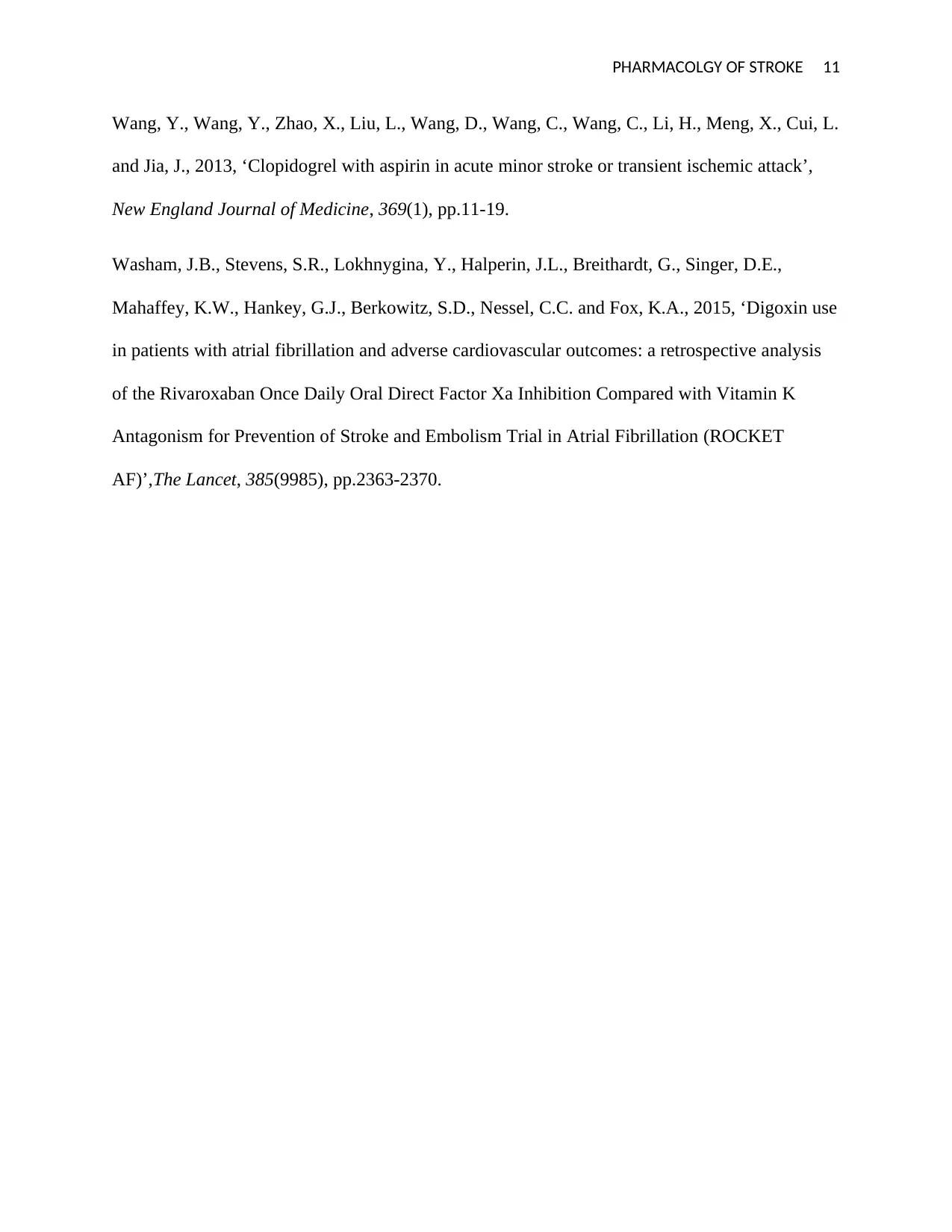
PHARMACOLGY OF STROKE 11
Wang, Y., Wang, Y., Zhao, X., Liu, L., Wang, D., Wang, C., Wang, C., Li, H., Meng, X., Cui, L.
and Jia, J., 2013, ‘Clopidogrel with aspirin in acute minor stroke or transient ischemic attack’,
New England Journal of Medicine, 369(1), pp.11-19.
Washam, J.B., Stevens, S.R., Lokhnygina, Y., Halperin, J.L., Breithardt, G., Singer, D.E.,
Mahaffey, K.W., Hankey, G.J., Berkowitz, S.D., Nessel, C.C. and Fox, K.A., 2015, ‘Digoxin use
in patients with atrial fibrillation and adverse cardiovascular outcomes: a retrospective analysis
of the Rivaroxaban Once Daily Oral Direct Factor Xa Inhibition Compared with Vitamin K
Antagonism for Prevention of Stroke and Embolism Trial in Atrial Fibrillation (ROCKET
AF)’,The Lancet, 385(9985), pp.2363-2370.
Wang, Y., Wang, Y., Zhao, X., Liu, L., Wang, D., Wang, C., Wang, C., Li, H., Meng, X., Cui, L.
and Jia, J., 2013, ‘Clopidogrel with aspirin in acute minor stroke or transient ischemic attack’,
New England Journal of Medicine, 369(1), pp.11-19.
Washam, J.B., Stevens, S.R., Lokhnygina, Y., Halperin, J.L., Breithardt, G., Singer, D.E.,
Mahaffey, K.W., Hankey, G.J., Berkowitz, S.D., Nessel, C.C. and Fox, K.A., 2015, ‘Digoxin use
in patients with atrial fibrillation and adverse cardiovascular outcomes: a retrospective analysis
of the Rivaroxaban Once Daily Oral Direct Factor Xa Inhibition Compared with Vitamin K
Antagonism for Prevention of Stroke and Embolism Trial in Atrial Fibrillation (ROCKET
AF)’,The Lancet, 385(9985), pp.2363-2370.
1 out of 11
Your All-in-One AI-Powered Toolkit for Academic Success.
+13062052269
info@desklib.com
Available 24*7 on WhatsApp / Email
![[object Object]](/_next/static/media/star-bottom.7253800d.svg)
Unlock your academic potential
© 2024 | Zucol Services PVT LTD | All rights reserved.


